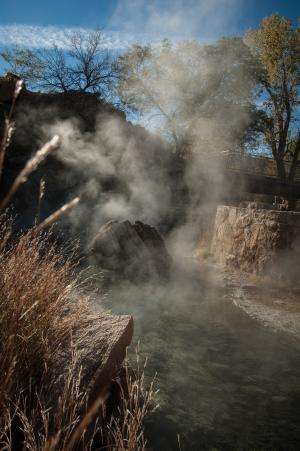Home toxic home

Most organisms would die in the volcanic sulfur pools of Yellowstone and Mount Etna. Robust simple algae call it home, and their secrets to survival could advance human medicine and bioremediation.
Mike Garavito, Michigan State University professor of biochemistry and molecular biology was part of a research team that revealed how primitive red algae use horizontal gene transfer, in essence stealing useful genes from other organisms to evolve and thrive in harsh environments.
Their study, published in the current issue of Science, shows that the algae's ability to adapt to a hot and extremely acidic environment ¬lies in part in their membrane proteins.
"The algae's membrane proteins are biologically quite interesting because they're receptors and transporters, the same classes of proteins that play key roles in energy metabolism and human immune response," said Garavito. "This has applications in human medicine because virtually all of the important pathways that contribute to disease treatment involve membrane proteins."
What makes the algae's membrane proteins attractive as a model for humans is their robustness. Other traditional candidates, such as yeast, insect cell cultures and slime mold, are fragile. The algae give researchers extra time to manipulate and examine their membrane proteins.
Garavito was part of a team of researchers led by Andreas Weber, former MSU researcher now at Heinrich-Heine-Universitat Dusseldorf (Germany). While at MSU, Weber led a team in first sequencing the algae, one of the first major genome sequencing projects at MSU.
"Weber knew that this would be a good organism from which to harvest a wide variety of genes that could be potential models for those involved in human health and disease," said Dave Dewitt, associate dean of research at MSU's College of Natural Science. "From a biotechnology standpoint, this organism is the Wal-Mart of genomes; if it doesn't have what you're looking for, you probably don't need it."
Furthering the superstore metaphor, the research team also is spending time in the Wal-Mart genome's bioremediation aisle. In this capacity, scientists are quite interested in how the organisms manage toxic chemicals and heavy metal contamination. That's because these algae are found not only near geysers, but they also populate polluted slag pools and mines.
"This organism knows how to deal with leaching loads of heavy metals in a noxious environment," Garavito said. "This research could lead to enzymes that are needed to clean up mine and heavy-metal contamination."
Journal information: Science
Provided by Michigan State University











.jpg)




